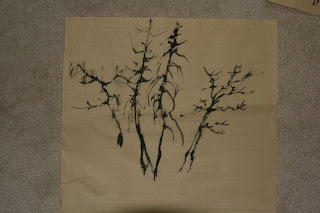I found a picture of a painting by some artist in the Ming Dynasty. The painting is deceptively simple, willow branches. What can be more difficult than drawing lines?
This piece of work is inspirational because of its simple premise..lines, brush strokes. We understand that Chinese brush painting has inextricable ties to calligraphy. My challenge now is to learn how to write this painting.
Examination of the painting quickly tells me two main branches (the 2 with the darkest ink tone) reside at the middle to right of the page, accompanied by another branch with slightly lighter ink tone to the far left. The spatial arrangement of these branches is most elegant. The "Shu" "Mi" ( sparse and dense) contrast is poetic. The weight of the painting seems to be at the top, since it is tracing back to the virtual main trunks, yet the flow of the juvenile branches are like dancing thunder bolts, emitting tangible energy. The casts in this painting must migrate towards gravity, yet be suspended by the lack of which.
The brush strokes are deliberate and expressive. One can discern the attacks of side-tip strokes by the sharp edges of the delta at the beginning of each stroke, and witness their eventual transformation to straight tipped diminuendos. So effortless and yet labored with punch. The artist was able to "write" this regal piece with feathery aplomb.
Typical downfalls in trying to emulate this painting include the following:
(note red circles in the pictures)
An example of overkill, trying too hard to depict the curly weaves
Hiccup strokes, lifting the brush at inappropriate times, too anxious to taper off
Inappropriate line widths, having no control on the pressure applied to the brush, usually a consequence of too much speed
Inappropriate "SHU" and "MI", the branches are too evenly distributed.
And I give up! Have another drink!
The dilemma is that if we pay too much attention on each brush stroke, we seem to miss out on addressing spatial presentation and spontaneity in the strokes and the result could be quite stoic.
The drawbacks of learning by rote is that we often forget what our mission is. Fundamentally, we need to have good technique and patience. There are no short cuts. After we've acquired the basics, then we can begin to analyse and "read" a painting, understand it and emulate it and learn from the process. I like to take a segue by stating that I've been accused of keeping bad company, i.e. I did not pick good paintings to learn from. I need a cleansing from my rote learning!
I know of people who would lay their Xuan over images to copy them. To them the "authentic likeness" is of sole importance. We must understand that the painting does not represent only ONE moment, but a continuum of frames. My mentor always said painting is like dancing, a string of motions. Don't get caught up in a "pose" captured by the flashlight. That "pose" does not describe the dance.
"Now you tell me", quipped this sophomoric individual. His frustration was obvious, only to have his ignorance fueled by the desire of Ramen instant noodles.
For all of us who appreciate this art form, don't go over to the Dark Side, albeit tempting. Don't be a Faustian, the reward is picayune.


























